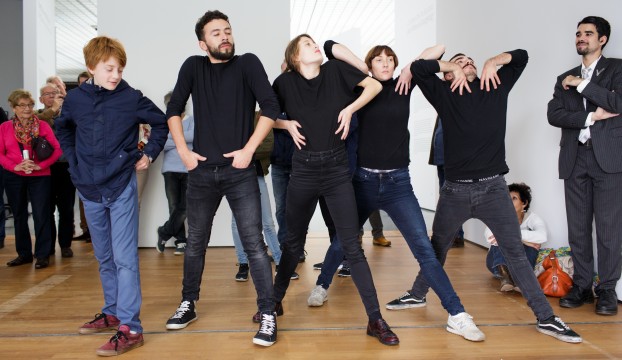
Dancing Museums II
Which habits determine how we move through a museum? How do they influence what we see and do not see? For the Dancing Museums research project, choreographer Ingrid Berger Myhre of Dansateliers is conducting two years of research into these questions at Museum Boijmans van Beuningen in collaboration with other choreographers. By participating in Dancing Museums, the museum aims to encourage cross-fertilisation between the disciplines of dance and the visual arts.

Dancing Museums II - The Democracy of Beings
Dancing Museums is a European interdisciplinary research project that brings together dance and the visual arts. How can dance influence and deepen our experience of looking at art? How can art be a source of inspiration for dance? Five dance organisations from different European cities have each selected a talented young choreographer to explore these issues.
At the initiative of Dansateliers, Museum Boijmans van Beuningen and Dansateliers are working together for the second time. Berger Myhre’s research takes place within the context of similar collaborations in France, Germany, Great Britain, Italy, Spain, the Czech Republic and other countries, in which a choreographer is conducting research in a museum. During these international residences, choreographers and museums learn from each other’s ideas and exchange knowledge.
Crossovers in the museum
Boijmans has a rich tradition of interdisciplinary partnerships. For example, for some years we have been working together with the Rotterdam Philharmonic Orchestra on the programme Between Art and Sound. We also organise mindfulness sessions in the museum, host the music competition ART Rocks and we have developed the Yeah Boij programme with the HipHop House. There are various reasons for organising these partnerships. Opening the museum to other disciplines can encourage new audiences and these interdisciplinary partnerships also help to bring works of art to life, allowing visitors to see them from a new perspective and to develop their own personal interpretations.





In Transit
Museum Boijmans van Beuningen is undertaking a large-scale renovation over the next few years and is exhibiting its collection at other locations in Rotterdam. Ingrid Berger Myhre is moving with the collection and conducting research at the various neighbouring venues, including the Stedelijk Museum Schiedam, the Maritime Museum and Museum Rotterdam.

Ingrid Berger Myhre: ‘Like me, the museum is on the move. It has moved to new accommodation and is undergoing a transition as an organisation. I am formally in residence at Museum Boijmans, but I will work at other museums and venues in Rotterdam that lend me their space. One week I will be at the Stedelijk Museum Schiedam and the next week I might work at another location.’ ‘These working conditions force me to look less at the artworks themselves and more at the structures and conventions in these places. I am investigating what role choreography can play in this, and I’m making more connections with the spaces and the people within these spaces.’
The character of Depot Boijmans Van Beuningen, currently under construction, fits seamlessly with the core question of Berger Myhre’s research into which habits determine how visitors move through a museum. Depot Boijmans Van Beuningen is the world’s first fully accessible art storage facility. The Depot has a different dynamic to that of the museum: it is not a venue for exhibitions, but visitors can you can browse amongst 151,000 art objects, with or without a guide. The works are not arranged in art historical sequence, but are presented in constantly changing displays that emphasise the diversity of the museum’s vast collection. There are also four galleries with presentations of works from the collection that change more frequently than those in the Atrium. Visitors can also observe conservation and restoration projects. In addition to periods of research at neighbouring locations, Berger Myhre will spend some time conducting research at Depot Boijmans Van Beuningen.
Partners
In addition to Dansateliers, the other participants include La Briqueterie (FR), Dance4 (GB), Commune di Bassano del Grappa (IT), Mercats de les Flors (ES) and Tanec Praha (CZ). The museum partners are Museum Boijmans Van Beuningen (NL), Bundeskunsthalle (DE), MAC VAL Museum Contemporain (FR), Nottingham Contemporary (GB), Nottingham City Museums and Galleries (GB), Prague City Gallery (CZ), Museo Civico di Bassano del Grappa (IT) and Fundació Joan Miró – Barcelona (ES). Dancing Museums is supported in part by the Creative Europe Program of the European Commission.
You can follow the entire Dancing Museums project at www.dancingmuseums.com.
Look back at Dancing Museums I (2015 - 2017)
During Dancing Museums I, five choreographers appointed by the organising museums embarked on a two-year research and development programme to explore new ways of interacting with the public. The aim of the project was to offer the viewer a richer and deeper experience of art. After a series of residences in various major museums, Dancing Museums culminated in the exhibition La Cité (éphémère) de la danse at the Musée d'Art Contemporain du Val-de-Marne (MAC/VAL) in Paris. For the first edition of the project, Dansateliers invited choreographer Connor Schumacher. During the first Rotterdam residency, he collaborated with visual artist Luis Rios Zertuche.



